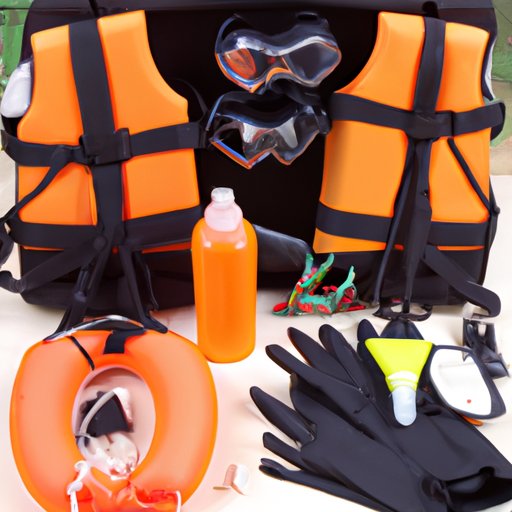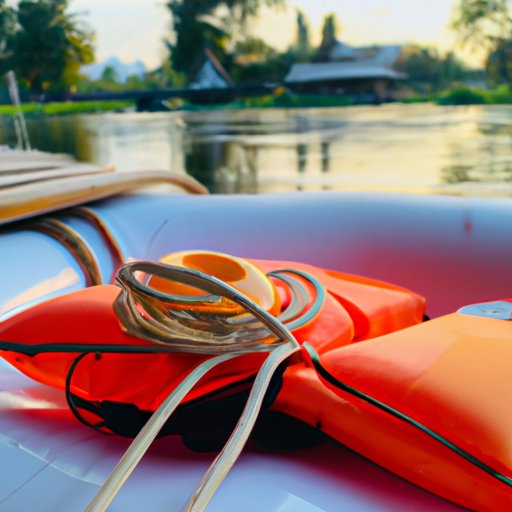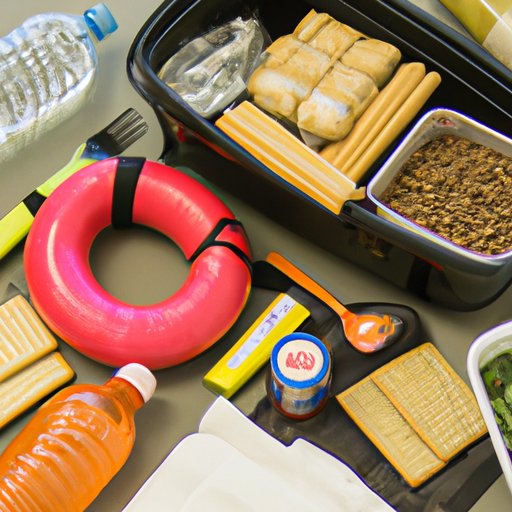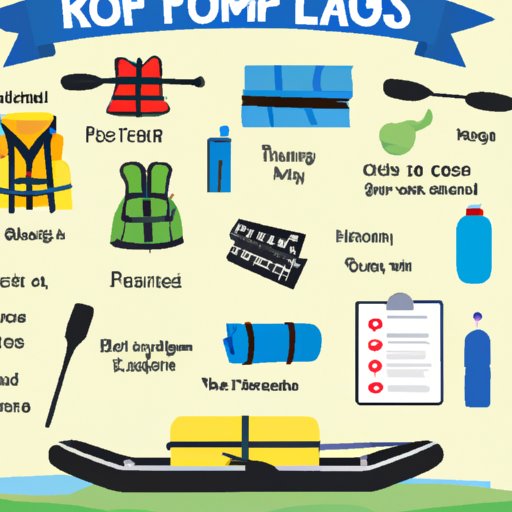Introduction
A float trip is one of the most enjoyable outdoor activities you can do with friends or family. It involves taking a leisurely journey down a river in a canoe, kayak, raft, or other watercraft, soaking in the scenery and wildlife along the way. To make sure your float trip is safe and comfortable, it’s important to plan ahead and bring the necessary gear and supplies. In this article, we’ll explore what to take on a float trip and provide some helpful tips for a successful journey.
Packing List: What to Bring on a Float Trip
When planning a float trip, there are certain essentials you should always bring along. Here’s a look at what to take on a float trip:
Essential Gear
First and foremost, you’ll need the right type of boat and gear for your float trip. This includes a canoe, kayak, raft, or other watercraft suitable for the size and type of river you’ll be traveling on. If you’re renting a boat, make sure it’s the right size for the number of people who will be on board. You’ll also need to bring paddles and oars, as well as any other accessories such as anchor lines, ropes, and dry bags.
Clothing
When choosing clothing for your float trip, opt for lightweight, quick-drying materials. Avoid cotton as it will become heavy when wet and take longer to dry. For sunny days, wear a hat and sunglasses, and don’t forget to bring a swimsuit for taking a dip in the river.
Food and Drinks
You’ll want to bring plenty of food and drinks for your float trip. Non-perishable items such as trail mix, jerky, and energy bars are great options. Quick-to-prepare meals such as instant oatmeal, mac and cheese, and ramen noodles are also convenient. Don’t forget to bring plenty of snacks and treats such as granola bars, chips, and candy. And make sure to have plenty of water and other beverages, such as sports drinks, juice boxes, and tea.
First Aid and Safety Items
It’s always a good idea to bring a first aid kit and other safety items on a float trip. Make sure to include bandages, gauze, antiseptic wipes, tweezers, and over-the-counter medications such as ibuprofen and antihistamines. You should also bring a whistle and signal mirror if you’re going to be in a remote area.

Essential Safety Gear for Your Float Trip
In addition to the items mentioned above, it’s important to bring along some essential safety gear on a float trip. Here are some items you should consider bringing:
Life Jackets
Life jackets are a must for any float trip. Make sure everyone in your group has a properly fitting life jacket that is U.S. Coast Guard approved. It’s also a good idea to bring extra life jackets for guests or children who may not have their own.
Sunscreen and Insect Repellent
Protect yourself from the sun and insects by bringing along sunscreen and insect repellent. Look for products that are designed for outdoor use and are waterproof. Make sure to reapply sunscreen throughout the day, especially after swimming or getting out of the water.
Emergency Supplies
It’s wise to bring some emergency supplies on a float trip. This includes items such as a map and compass, fire starter and waterproof matches, a flashlight, and a pocket knife. You may also want to bring a satellite phone or two-way radio if you’re going to be in a remote area.

Tips for Staying Comfortable on the River
To ensure a comfortable and enjoyable float trip, there are a few things you can do to stay comfortable on the river. Here are some tips to keep in mind:
Clothing Choices
Choose clothing that is lightweight and breathable to help keep you cool on hot days. You may want to bring a pair of shorts, a light long-sleeved shirt, and a pair of sandals or water shoes. Don’t forget to bring a windbreaker or raincoat in case of sudden weather changes.
Sun Protection
Be sure to wear a hat and sunglasses to protect your eyes and skin from the sun’s harmful rays. It’s also a good idea to bring along a beach umbrella or canopy to provide shade while you’re on the river.
Hydration and Nutrition
Staying hydrated and eating nutritious meals are essential for a successful float trip. Bring plenty of water and other drinks, and try to eat small meals throughout the day. Pack easy-to-eat snacks such as trail mix, granola bars, and fruit to keep your energy levels up.
How to Choose the Right Boat and Gear for Your Float Trip
The type of boat and gear you choose for your float trip will depend on the size and type of river you’ll be traveling on. Here are some tips for choosing the right boat and gear:
Size and Type of Boat
If you’re renting a boat, make sure it’s the right size and type for the number of people who will be on board. You may want to rent a larger boat if you’re traveling with more than three people. For smaller rivers, a canoe or kayak is usually the best option. If you’re traveling on a larger river, you may want to consider a raft or other type of watercraft.
Paddles and Oars
Make sure to bring the right type of paddles and oars for your boat. Canoes and kayaks typically require single-blade paddles, while rafts require oars. If you’re renting a boat, the rental company should provide the right type of paddles or oars for the boat.
Other Accessories
Don’t forget to bring other accessories such as anchor lines, ropes, and dry bags. You may also want to bring a fishing rod if you’re planning to fish along the way.
Strategies for Planning and Enjoying a Successful Float Trip
Before you embark on a float trip, there are some strategies you should follow to ensure a successful outing. Here are some tips for planning and enjoying a successful float trip:
Researching the Route
Do your research before heading out on the river. This includes learning about the river’s current level and flow rate, as well as any rapids or obstacles you may encounter along the way. Make sure to check the weather forecast as well to prepare for any unexpected weather changes.
Obtaining Permits
If you’re traveling on a river with special regulations or permits, make sure to obtain the necessary permits before heading out. Contact the local park or forest service office to find out what permits are required and how to obtain them.
Preparing for Emergencies
It’s important to be prepared for emergencies while on the river. Make sure to bring a first aid kit and other emergency supplies, as well as a satellite phone or two-way radio if you’re going to be in a remote area. Additionally, be sure to let someone know where you’re going and when you plan to return.

The Best Foods to Pack for a Float Trip
When planning a float trip, it’s important to bring along the right type of food and drinks. Here are some ideas for the best foods to pack for a float trip:
Non-Perishable Items
Non-perishable items such as trail mix, jerky, and energy bars are great for a float trip. They are lightweight and easy to transport, and they won’t spoil in the heat.
Quick-to-Prepare Meals
Quick-to-prepare meals such as instant oatmeal, mac and cheese, and ramen noodles are also convenient. These types of meals are easy to make and require minimal effort.
Snacks and Treats
Don’t forget to bring some snacks and treats on your float trip. Granola bars, chips, and candy are all good options. You may also want to bring fruits such as apples, oranges, and bananas.
Conclusion
A float trip is a great way to spend quality time with friends or family and enjoy the beautiful outdoors. To make sure your float trip is safe and comfortable, it’s important to plan ahead and bring the necessary gear and supplies. In this article, we explored what to take on a float trip and provided some helpful tips for having a successful outing. We discussed essential gear, such as the right type of boat and paddles, clothing, food and drinks, first aid and safety items, and emergency supplies. We also looked at strategies for planning and enjoying a successful float trip, as well as the best foods to pack. Now that you know what to take on a float trip, you’re ready to set off on your next adventure!
(Note: Is this article not meeting your expectations? Do you have knowledge or insights to share? Unlock new opportunities and expand your reach by joining our authors team. Click Registration to join us and share your expertise with our readers.)
